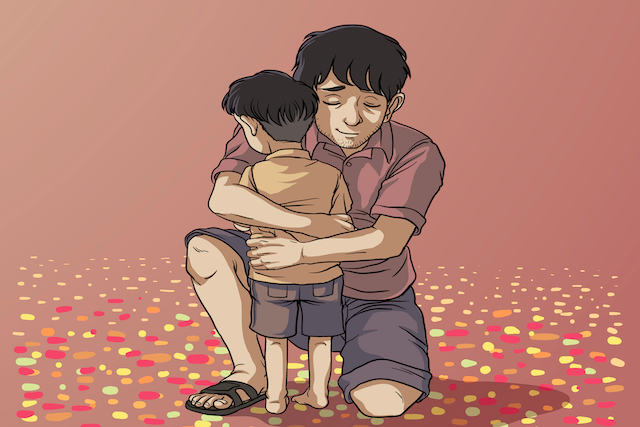
“She held herself until the sobs of the child inside subsided entirely. I love you, she told herself. It will all be okay.” ~H. Raven Rose
The first time I heard about inner child work was in a random article I found on the internet.
It caught my attention because I was struggling to develop loving and compassionate feelings toward myself. Although I understood the role of limiting beliefs and unhealthy habits in my healing process and how to overcome them, I couldn’t feel love and empathy for myself.
Most of the time, I was either very harsh toward myself for any minor mistake or denied feelings that came up.
For example, as a teenager and a young adult, I struggled with anger. As I got older, I realized that emotional outbursts aren’t healthy, so I began to mask my anger with passive aggressiveness. However, the shame around anger remained because there were times when I still felt strong and intense anger. I just got better at hiding it. Or so I thought.
I felt anger quite often, and I couldn’t stand it. I got angry with myself for being angry.
The same denial and frustration applied to other emotions that made me feel vulnerable, like shame, guilt, or judgment.
Because of the work I was doing with women, I thought I should be somewhere else, focusing on blooming flowers and appreciating the sunshine. In the meantime, I didn’t feel like I was walking my talk. And that, with no surprise, brought more shame and anger.
Then, one day, my fridge broke down.
I began to deal with the issue, trying to schedule maintenance. As I was driving to meet with a client, I received an email regarding appointment times that wouldn’t work for me, and there wasn’t a lot of flexibility in rescheduling.
Suddenly, I felt an intense upsurge of anger and frustration flooding my body. Although I was able to witness it without reacting, it alarmed me since I hadn’t felt this way in a long time. Tears started to run down my cheeks.
I felt defeated while asking myself, “Why am I feeling this way? Why are these emotions still here? When is it going to stop?”
As I was trying to wipe my tears while navigating rush-hour traffic, a thought came to mind: “It’s okay to feel angry.”
I placed my hand on my chest, briefly closed my eyes as I was waiting at a red light, and whispered, “I see you” (referring to my inner child, recognizing her acting up by being angry).
Soon after, something unexpected happened.
I opened my eyes and felt a profound sense of lightness. The anger had left my body.
I was in awe. More tears began rolling down my face, but this time from gratitude for the acceptance and grace I was able to give to myself.
I realized that the whole time I was suppressing my anger, the inner version of me was asking for acceptance. She wanted to be seen and acknowledged, without judgment. It felt as if my inner child had been trying to get my attention and show me something (as kids do), but I kept pushing her away while being busy with other stuff.
The moment I turned to her and gave her the attention she needed, she settled down.
After this profound experience, I began to dive deeper into this healing modality and understood four things about the inner child in all of us.
1. Our inner child wants to be seen.
When we are acting on our triggers and behaving in ways that we know are not healthy for us, it means that our inner child is acting up. I always visualize a scene of a little girl or boy pulling their mom’s sleeve, trying to show her something. It’s like they are saying, “Mom, look. Mom, pay attention to me. There is something important I want to show you.”
When emotions we don’t like come up, or we act in the same old ways that bring judgment, our inner child is simply trying to get our attention. He or she wants to be seen, recognized, and acknowledged.
One of the questions I ask my inner child when she is (I am) acting up is, “What are you trying to tell me?” When I do it with my eyes closed, the answer is almost instant.
2. Our inner child wants to be validated.
Most of us have had experiences when we got hurt but didn’t receive an apology.
We’ve also had experiences when the person who hurt us apologized with sincerity. I’m guessing that at least half of our healing took place at that very moment. Instead of being ridiculed or dismissed, we were validated.
The same applies to our inner children. As I previously described, only when I justified my little girl’s emotions instead of dismissing her did I experience emotional release and healing.
Since inner child work is about reparenting ourselves, this is how we can understand it. I look at my subconscious mind as my inner child. That’s where all my beliefs, perceptions, and triggers are stored. My conscious mind is my parent. This part of me is logical, able to question my limiting beliefs and actively acknowledge and heal the wounds that are there.
The beauty of inner child work is that we don’t need apologies from those who we feel wronged us.
Since we are in the position of a parent and a child, we can give our inner child anything s/he needs.
3. Our inner child is missing and seeking love.
Love is the most resilient emotion. It gives us courage, strength, determination, gratitude, and acceptance, and it is often the emotion that our inner child craves the most.
After we acknowledge and validate our inner child, we can soothe them with loving affirmations and words of encouragement.
Here is a simple exercise I learned from a guided meditation.
Close your eyes and take three deep, cleansing breaths. Bring into your vision a simple bench where you and your inner child are sitting together. First, ask your inner child if you can hold his or her hand. Once you receive permission, gently stroke your child’s hand and say the ancient Hawaiian Ho’oponopono mantra three times.
I am sorry.
Please forgive me.
I love you.
Thank you.
When I practice this mantra, I use the first affirmation, “I am sorry,” to apologize to my inner child for any pain and hurt I caused her by not paying attention to her when she needed me. Then, I ask her to forgive me for denying her presence and the healing she was so desperately asking for.
These first two mantras are deeply healing because once I forgive myself for betraying myself and my inner child, I feel instant relief and more drive to keep going. I am not paralyzed by subtle guilt anymore.
In the end, I reassure her that I am here for her by saying that I love her and then thank her for giving me this opportunity to heal both of us.
4. Our inner child is a gateway to heartfelt emotions.
Often, when I see a child, there is a level of softness that enters my body. I attribute it to the innocence and sweetness children represent.
Imagine yourself being upset, and suddenly a three-year-old comes in front of you and starts smiling. Whether you want it or not, it will affect you to some extent, and you may even smile back.
We can embrace the same dynamic with our inner child and use it as a way to feel heartfelt emotions. One of those ways is to use the visualization exercise I shared with you earlier.
The more we practice feeling love, compassion, and empathy toward our little selves, the more accustomed we become to feeling these emotions.
Although guilt, judgment, shame, or anger may still arise, instead of judging or denying them, we can use compassion and curiosity to understand what these emotions are trying to tell us.
By validating and accepting what we feel, we can reparent ourselves, heal our wounds, and start living from the most powerful place there is—the place of love.
About Silvia Turonova
Silvia Turonova is a women’s mindset coach who leads women toward emotional healing while empowering them to live a life of wholeness, balance, and inner resilience. She loves writing and serving women through her blog. You can find out more about working with her and her 1-on-1 coaching program COACH Intensive here or get her free self-coaching worksheet here.













 Though I run this site, it is not mine. It's ours. It's not about me. It's about us. Your stories and your wisdom are just as meaningful as mine.
Though I run this site, it is not mine. It's ours. It's not about me. It's about us. Your stories and your wisdom are just as meaningful as mine. 